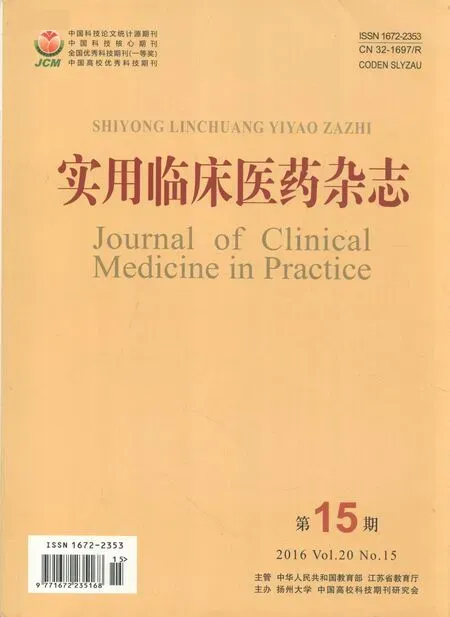不同剂量右美托咪定复合罗哌卡因行肌间沟臂丛神经阻滞的阻滞效果和不良反应
陈 晨,高共鸣
(1.江苏省常州市第一人民医院 麻醉科,江苏 常州,213000; 2.江苏省常州市第二人民医院 骨科,江苏 常州,213000)
不同剂量右美托咪定复合罗哌卡因行肌间沟臂丛神经阻滞的阻滞效果和不良反应
陈晨1,高共鸣2
(1.江苏省常州市第一人民医院 麻醉科,江苏 常州,213000; 2.江苏省常州市第二人民医院 骨科,江苏 常州,213000)
摘要:目的探讨两种不同剂量的右美托咪定复合罗哌卡因行肌间沟臂丛神经阻滞的效果和不良反应。方法40例行单侧上肢/手部手术的患者随机分为两组,即0.5 μg/kg右美托咪定复合罗哌卡因组(DR1组)和1 μg/kg右美托咪定复合罗哌卡因组(DR2组)。比较2组患者阻滞起效时间,阻滞后4、6、8、10、12和14 h的静息和运动阻滞效果,术后血流动力学改变和镇静等不良反应。结果DR1组患者感觉和运动阻滞开始恢复和完全恢复的时间均显著早于DR2组患者 (P<0.01); DR2组在6 h活动疼痛评分和术后8、10、12和14 h的静息和活动疼痛评分均显著优于DR1组(P<0.05)。结论1 μg/kg右美托咪定复合罗哌卡因较0.5 μg/kg右美托咪定复合罗哌卡因用于肌间沟臂丛神经阻滞,可以增强臂丛神经阻滞效果且不增加不良反应。
关键词:右美托咪定; 罗哌卡因; 肌间沟臂丛神经阻滞
臂丛神经阻滞单独用于上肢和手部手术常能取得较好的麻醉效果。罗哌卡因具有长达8~14 h的阻滞效果和较高的安全性,成为外周神经阻滞首选局麻药[1-4]。阿片类药物能引起恶心、呕吐、便秘等胃肠道反应和皮疹、瘙痒等过敏反应,甚至呼吸抑制[5]。动物实验和受试者在体研究[6-13]均发现α2受体激动剂+局麻药鞘内注射或者行外周神经阻滞可能延长局麻药作用时间。荟萃分析[14]发现,右美托咪定辅助鞘内注射延长感觉和运动阻滞的确切效果,而外周神经阻滞加用右美托咪定能延长感觉和运动阻滞时间。动物研究和在体实验[8,15]均表明右美托咪定延长局麻药的阻滞效果有剂量依赖性。本研究比较罗哌卡因联合两种常用剂量右美托咪定(0.5,1 μg/kg)用于臂丛神经阻滞的效果及对于术后不良反应的影响,现报告如下。
1资料与方法
1.1一般资料
选择2015年9月—2016年2月在常州市第一人民医院骨科行上肢/手部手术患者40例,经常州市第一人民医院伦理委员会同意,并获得患者或其委托人签署的知情同意书。患者入选标准为择期行单侧上肢/手部手术,接受单独肌间沟臂丛神经阻滞的患者,ASA Ⅰ~Ⅲ级。排除标准:① 拒绝外周神经阻滞或者阻滞失败; ② 因凝血功能障碍、皮肤感染或者对罗哌卡因过敏无法进行外周神经阻滞; ③ 听力或语言严重受损交流不畅; ④ 糖尿病血糖控制不佳或者合并外周神经病变; ⑤ 严重的心血管病变; ⑥ 肝功能或者肾功能不全; ⑦ 长期自我服用止痛药; ⑧ 严重的呼吸系统疾病; ⑨ 长期服用可乐定、酒精或者药物成瘾患者; ⑩ BMI>35 kg/m2。根据计算机软件生成的随机数字表将40例患者随机分为2组,即右美托咪定(0.5 μg/kg)1 mL+0.5%罗哌卡因15 mL(DR1组)和右美托咪定(1 μg/kg)1 mL+0.5%罗哌卡因15 mL(DR2组),每组20例。2组患者的性别、年龄、BMI、ASA分级、术前疼痛评分均无显著差异(P>0.05)。见表1。

表1 DR1组和DR2组基线资料比较
1.2方法
手术当日清晨将患者接入手术室,连接标准监护导联,开放外周静脉,给予0.02 mg/kg咪达唑仑镇静和50 μg芬太尼镇痛,并用鼻导管1~2 L/min流量吸氧。消毒铺单之后在超声引导下辨别臂丛神经结构,用平面内技术引导穿刺针进行上、中、下3点注射阻滞臂丛神经,每点注射5 mL复合溶液,由同一人完成操作。超声均采用高频线阵探头10~20 Hz(Sonosite,Sonosite Inc.,USA)。阻滞完成后,由另1名麻醉助理医师每2 min评估1次患者感觉和神经阻滞程度,直至达到手术要求。感觉阻滞应用针刺三分法确定手术区域阻滞程度:0分,感觉正常; 1分,有感觉但是不痛; 2分,无感觉。运动阻滞程度用上肢抬起程度来评估:0分,运动正常; 1分,能稍抬起但无力; 2分,完全不能抬起。
1.3观察指标
观察阻滞后2、4、6、8、10、12和14 h的阻滞情况。① 疼痛指标:应用视觉模拟评分法(VAS)评价疼痛程度(0分,无痛;10分,剧烈疼痛); ② 感觉阻滞时长:应用C5皮区感觉消失时间计算; ③ 运动阻滞时长:应用肱二头肌肌力恢复评价运动阻滞时长(0级,完全瘫痪;1级,可收缩;2级,不能抗重力; 3级,抗重力不抗阻力; 4级,可抗弱阻力; 5级,正常); ④ 若患者感觉神经阻滞超过14 h,由患者自述或者陪护告知夜间阻滞消失时间,并与已有的护理记录核对,记录准确时间; ⑤ 不良反应:窦缓、低血压、呼吸抑制与过度镇静(Ramsay镇静评分:1分为烦躁不安; 2分为清醒,安静合作;3分为嗜睡,对指令反应敏捷;4分为浅睡眠,可迅速唤醒;5分为入睡,反应迟钝;6分为深睡眠,无法唤醒)。已有的研究[16-17]表明,罗哌卡因单独镇痛持续时间平均为11.1 h(SD5)。Ⅰ类错误双侧0.05%,把握度80%,失访率15%的条件下,每组20个患者能够检测出4 h镇痛时间差异。
1.4统计学方法
采用SPSS 21.0录入数据分析。计量资料用均数±标准差表示,组间比较采用t检验,计量资料用χ2检验,等级资料用Wilcoxon秩和检验。
2结果
DR2组感觉和运动阻滞起始时间和完全起效时间均快于DR1组。DR1组患者感觉和运动阻滞开始恢复和完全恢复的时间均显著早于DR2组患者(P<0.01); 2组患者在4、6 h静息疼痛评分以及4 h活动疼痛评分比较无显著差异(P>0.05)。 DR2组在6 h活动疼痛评分和术后8、10、12和14 h的静息和活动疼痛评分均显著优于DR1组(P<0.05)。见表2。DR2组患者心率低于DR1组。2组各时间点血压无显著差异(P>0.05)。见图1、2。2组在PACU和病房的镇静评分无显著差异(P>0.05)。2组患者术后均未出现严重并发症。DR2组有1例患者出现术后呕吐。2组患者均无明显口干、头晕、谵妄、尿潴留等。

表2 2组静息痛和活动痛VAS评分
与DR1组比较,*P<0.05,**P<0.01。

图1 2组手术室和术后病房心率比较

图2 2组手术室和术后病房MAP比较
3讨论
超声的使用使得神经阻滞“可视化”,缩短了操作时间,避免了血管内或者神经内注射,提高单次注射大剂量局麻药和辅助药的安全性,保证了阻滞效果。α2受体激动剂复合局麻药用于外周神经阻滞已有临床研究和报道。大型荟萃分析[14,18]发现右美托咪定复合局麻药能够延长局麻药阻滞效果。大鼠实验[12]发现,右美托咪定复合罗哌卡因具有浓度依赖性的延长感觉和神经阻滞的作用。本研究首次在同一个随机对照研究中比较了两种不同剂量右美托咪定(0.5、1 μg/kg)复合常用剂量罗哌卡因的起效时间、感觉和运动阻滞时长以及不良反应的发生情况,探讨了α2受体激动剂右美托咪定复合局麻药在外周神经阻滞的临床使用价值和安全剂量。
α2受体激动剂复合局麻药可能增强鞘内注射和外周神经阻滞镇痛效果的确切机制尚不十分明确。右美托咪定具有中枢性镇痛作用,但研究[19]表明腹腔注射右美托咪定在中枢达到提高镇痛作用的阈值ED50为144 μg/mg,而局部注射右美托咪定远远小于该浓度[20]。因此可以排除右美托咪定的中枢镇痛作用。Brummett等[13]研究发现,预先给予α1和α2受体拮抗剂并不能减弱右美托咪定复合罗哌卡因的镇痛效果,但能够减弱肾上腺素和硬膜外给予右美托咪定的作用。因此推测右美托咪定在外周可能通过下述机制发挥作用:一是收缩血管,延长局部麻醉药物吸收时间,延长阻滞效果[21]; 二是可能直接作用外周血管或者神经发挥作用[22-23]。
右美托咪定引起血液药物浓度升高可能导致血流动力学变化和镇静等不良反应。本研究在手术室1 h内和术后病房1 h内未见明显的血流动力学差异。研究[24-25]表明右美托咪定在重症监护镇静的血药浓度为0.4~0.8 ng/mL,而半衰期为1.8~2.2 h。个别研究[20]报道了外周神经阻滞复合应用右美托咪定后的血药浓度发现,注射后30 min临床血药浓度最高,可达镇静深度,后逐渐下降。因此作者推测两种常用临床剂量的右美托咪定复合局麻药用于外周神经阻滞其安全性无明显差异。作者推测1 μg/kg右美托咪定复合罗哌卡因较0.5 μg/kg右美托咪定复合罗哌卡因用于肌间沟臂丛神经阻滞可以增强临床感觉和运动神经阻滞效果,且不增加不良反应。
参考文献
[1]Casati A,Fanelli G,Albertin A,et al.Interscalene brachial plexus anesthesia with either 0.5% ropivacaine or 0.5% bupivacaine[J].Minerva Anestesiol,2000,66(1/2):39-44.
[2]Casati A,Fanelli G,Aldegheri G,et al.Interscalene brachial plexus anaesthesia with 0.5%,0.75% or 1% ropivacaine:a double-blind comparison with 2% mepivacaine[J].Br J Anaesth,1999,83(6):872-875.
[3]Gautier P,Vandepitte C,Ramquet C,et al.The minimum effective anesthetic volume of 0.75% ropivacaine in ultrasound-guided interscalene brachial plexus block[J].Anesth Analg,2011,113(4):951-955.
[4]Vandepitte C,Gautier P,Xu D,et al.Effective volume of ropivacaine 0.75% through a catheter required for interscalene brachial plexus blockade[J].Anesthesiology,2013,118(4):863-867.
[5]Apfelbaum JL,Gan TJ,Zhao S,et al.Reliability and validity of the perioperative opioid-related symptom distress scale[J].Anesth Analg,2004,99(3):699-709.
[6]Brummett C M,Norat M A,Palmisano J M,et al.Perineural administration of dexmedetomidine in combination with bupivacaine enhances sensory and motor blockade in sciatic nerve block without inducing neurotoxicity in rat[J].Anesthesiology,2008,109(3):502-511.
[7]Brummett C M,Amodeo F S,Janda A M,et al.Perineural dexmedetomidine provides an increased duration of analgesia to a thermal stimulus when compared with a systemic control in a rat sciatic nerve block[J].Reg Anesth Pain Med,2010,35(5):427-431.
[8]Brummett C M,Padda A K,Amodeo F S,et al.Perineural dexmedetomidine added to ropivacaine causes a dose-dependent increase in the duration of thermal antinociception in sciatic nerve block in rat[J].Anesthesiology,2009,111(5):1111-1119.
[9]Esmaoglu A,Yegenoglu F,Akin A,et al.Dexmedetomidine added to levobupivacaine prolongs axillary brachial plexus block[J].Anesth Analg,2010,111(6):1548-1551.
[10]Marhofer D,Kettner SC,Marhofer P,et al.Dexmedetomidine as an adjuvant to ropivacaine prolongs peripheral nerve block:a volunteer study[J].Br J Anaesth,2013,110(3):438-442.
[11]Obayah G M,Refaie A,Aboushanab O,et al.Addition of dexmedetomidine to bupivacaine for greater palatine nerve block prolongs postoperative analgesia after cleft palate repair[J].Eur J Anaesthesiol,2010,27(3):280-284.
[12]Swami S,Ladi S,Keniya V,et al.Comparison of dexmedetomidine and clonidine (α2agonist drugs) as an adjuvant to local anaesthesia in supraclavicular brachial plexus block:A randomised double-blind prospective study[J].Indian Journal of Anaesthesia,2012,56(3):243-249.
[13]Brummett C M,Hong E K,Janda A M,et al.Perineural dexmedetomidine added to ropivacaine for sciatic nerve block in rats prolongs the duration of analgesia by blocking the hyperpolarization-activated cation current[J].Anesthesiology,2011,115(4):836-843.
[14]Abdallah FW,Brull R.Facilitatory effects of perineural dexmedetomidine on neuraxial and peripheral nerve block:a systematic review and meta-analysis[J].Br J Anaesth,2013,110(6):915-925.
[15]Bonnet F,Brun-Buisson V,Saada M,et al.Dose-Related Prolongation of Hyperbaric Tetracaine Spinal Anesthesia by Clonidine in Humans[J].Anesthesia & Analgesia,1989(5):619-622.
[16]Casati A,Fanelli G,Albertin A,et al.Interscalene brachial plexus anesthesia with either 0.5% ropivacaine or 0.5% bupivacaine[J].Minerva Anestesiol,2000,66(1/2):39-44.
[17]Gautier P,Vandepitte C,Ramquet C,et al.The minimum effective anesthetic volume of 0.75% ropivacaine in ultrasound-guided interscalene brachial plexus block[J].Anesth Analg,2011,113(4):951-955.
[18]Lundblad M,Trifa M,Kaabachi O,et al.Alpha-2 adrenoceptor agonists as adjuncts to peripheral nerve blocks in children:a meta-analysis[J].Paediatr Anaesth,2016,26(3):232-238.
[19]中华医学会麻醉学分会.右美托咪定临床应用指导意见(2013)[J].中华医学杂志,2013,93(35):2775-2777.
[20]Fritsch G,Danninger T,Allerberger K,et al.Dexmedetomidine added to ropivacaine extends the duration of interscalene brachial plexus blocks for elective shoulder surgery when compared with ropivacaine alone:a single-center,prospective,triple-blind,randomized controlled trial[J].Reg Anesth Pain Med,2014,39(1):37-47.
[21]Singelyn F J,Dangoisse M,Bartholomée S,et al.Adding clonidine to mepivacaine prolongs the duration of anesthesia and analgesia after axillary brachial plexus block[J].Reg Anesth,1992,17(3):148-150.
[22]Butterworth JF 5th,Strichartz G R.The alpha 2-adrenergic agonists clonidine and guanfacine produce tonic and phasic block of conduction in rat sciatic nerve fibers[J].Anesth Analg,1993,76(2):295-301.
[23]Gaumann D M,Brunet P C,Jirounek P.Clonidine enhances the effects of lidocaine on C-fiber action potential[J].Anesth Analg,1992,74(5):719-725.
[24]Potts AL,Anderson B J,Warman G R,et al.Dexmedetomidine pharmacokinetics in pediatric intensive care-a pooled analysis[J].Paediatr Anaesth,2009,19(11):1119-1129.
[25]Hoy S M,Keating G M.Dexmedetomidine:a review of its use for sedation in mechanically ventilated patients in an intensive care setting and for procedural sedation[J].Drugs,2011,71(11):1481-1501.
收稿日期:2016-04-19
中图分类号:R 614
文献标志码:A
文章编号:1672-2353(2016)15-053-04
DOI:10.7619/jcmp.201615015
Block effect and adverse reactions of different doses of dexmedetomidine combined with ropivacaine in patients with interscalene brachial plexus blocks
CHEN Chen1,GAO Gongming2
(1.Department of Anesthesiology,Changzhou First People′s Hospital,Changzhou,Jiangsu,213000; 2.Department of Orthopedics,Changzhou Second People’s Hospital,Changzhou,Jiangsu,213000)
ABSTRACT:ObjectiveTo explore the block effect and adverse reactions of different doses of dexmedetomidine combined with ropivacaine in patients with interscalene brachial plexus blocks.MethodsForty patients with elective upper limb/hand surgery were randomly divided into 0.5 μg/kg dexmedetomidine combined with ropivacaine group (group DR1) and 1 μg/kg dexmedetomidine combined with ropivacaine group (group DR2).Block onset time,resting and motor block effects at 4,6,8,10,12 and 14 hours after blocking as well as hemodynamic changes and adverse reactions were compared between two groups.ResultsThe time of sensory and motor block recovery in group DR1 were significantly shorter than those in group DR2 (P<0.05).The active pain score at 6 h and resting and active pain scores at 8,10,12,14 h in group DR2 were significantly better than those in group DR1 (P<0.05).ConclusionCombined with 0.5 μg/kg dexmedetomidine and ropivacaine,1 μg/kg dexmedetomidine combined with ropivacaine for interscalene brachial plexus blocks can improve block effect without increasing the adverse reactions.
KEYWORDS:dexmedetomidine; ropivacaine; interscalene brachial plexus blocks

